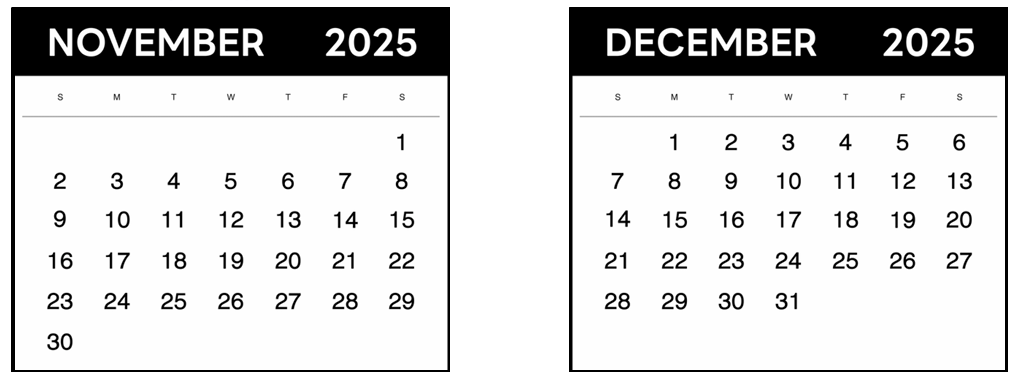Your Holiday Survival Guide: 5 Steps to a Balanced Approach to Nutrition This Season
The holiday season is fast approaching! While it’s a time meant for joy, celebration, and togetherness, it can also bring stress and overwhelm around food and nutrition. With travel, special meals, social events, and breaks in routine, it’s completely normal to feel like your usual habits get thrown off. For many, this spirals into extreme New Year’s resolutions that aren’t sustainable and often backfire.
The good news? Thriving during the holidays doesn’t require perfection. With a few simple strategies, you can enjoy the season, feel your best, and head into the New Year with confidence.
Let’s break it down:
1. Get a Holiday Snapshot: What’s Actually On Your Calendar?
Before the season ramps up, take one minute to map out the big picture. I like to physically mark up a calendar so I can clearly see what the rest of the year will look like and then reverse-engineer a realistic game plan from there.
Look at your schedule and highlight:
Travel days
Holiday parties
Major celebrations (Thanksgiving, Christmas Eve, Christmas day, New Years Eve, whatever you might celebrate!)
Work or school breaks
From there, you’ll easily be able to pinpoint days you’ll likely be home in your normal routine
After going through this exercise, most people realize far more days are typical than chaotic. And that perspective alone can reduce stress. Having 4-6 event-heavy days doesn’t mean the entire month is “off track.” It simply means a handful of days will look different, and that’s okay.
This exercise also helps you plan realistically instead of slipping into an all-or-nothing mindset where every day until January 1 feels like a free-for-all.
2. Consistent Meals Beats “Saving Up” Calories
One of the most common holiday nutrition traps is skipping meals before a big dinner or party to “save up” on calories. While it may seem logical, it often backfires: your hunger hormones surge, your blood sugar dips, and you arrive at the event ready to eat everything in sight.
Eating every 3-4 hours helps keep energy steady and prevents extreme hunger later in the day. This pattern is supported by research showing that consistent meal timing helps regulate appetite and metabolism.
Try writing down your ideal eating structure for a full day, such as:
Breakfast
Mid-morning snack
Lunch
Afternoon snack
Dinner
Optional treat
After writing down your ideal structure, double-check that you aren’t going more than 3-4 hours without a balanced meal or snack. Not every day will be perfectly timed (especially during travel!) but having a rough structure helps anchor the day.
3. Build a Balanced Holiday Plate
Holiday meals can feel “all or nothing,” but your plate can make room for tradition and nourishment.
A simple balanced structure:
~50% non-starchy carbs (green bean casserole, roasted Brussels sprouts, cranberry sauce)
~25% protein (turkey with gravy, ham, roast beef)
~25% starchy carbs (sweet potato casserole, stuffing, mac & cheese, cornbread pudding)
Using a visual guide like this helps ensure steady energy, stable blood sugar, and a sense of satisfaction rather than restriction. This mirrors principles of the USDA’s MyPlate model and meant to offer a fresh perspective on how a holiday plate can be enjoyed without overthinking every bite.
Remember: All foods can fit. Holiday dishes aren’t “good” or “bad,” they’re part of the celebration.
In the grand scheme of things, holiday meals make up a tiny fraction of the total meals you’ll eat throughout the year (or even throughout the season). So if your plate looks nothing like this, still no need to stress. What matters most is the broader context of your overall dietary pattern, not any single meal.
4. Choose 2 Mindful Habits for the Remainder of the Year
The holidays are chaotic enough, so resist the urge to overhaul your entire routine (which, by the way, is totally unsustainable). Instead, choose just one or two simple habits that feel both realistic and supportive of your wellbeing.
Examples:
Eat every 3-4 hours
Eat without distractions (i.e. no TV/doom scrolling)
Stay hydrated (choose a specific daily water goal: half your body weight in ounces can be a helpful general guideline)
Aim for a source of protein + fiber at each meal
Check in with hunger and fullness before/during/after meals
Or create your own!
Setting two focused habits gives you something achievable and repeatable to anchor you during a busy season, which sets you up for a few solid wins rather than burnout.
5. Get Support This Season: Work With a Registered Dietitian
If you’d feel more confident navigating the holidays with professional guidance, I’m here to help.
You can now work with me using insurance: I'm in network with Aetna, BCBS/Anthem, and UnitedHealthcare. I also accept HSA/FSA and can provide superbills for potential reimbursement if you’re out-of-network.
If you're ready for individualized support, accountability, and a personalized plan that fits your life (holidays included!), you can book a session with me today.


